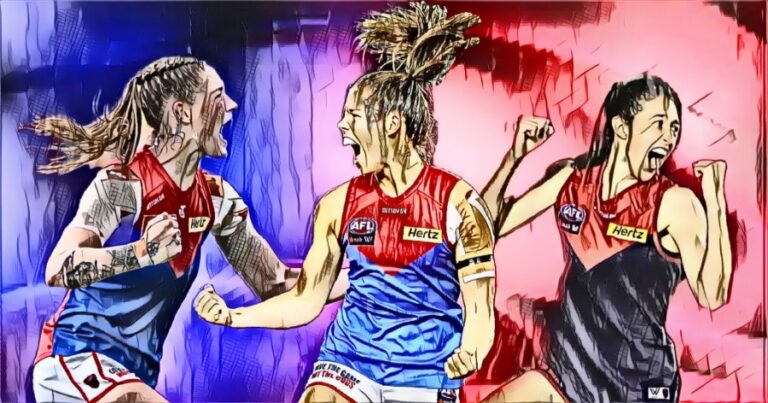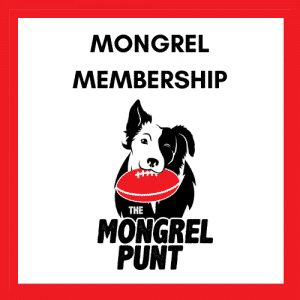Season seven was the year that Melbourne finally propelled themselves to be the best in the AFL women’s competition.
Season eight, they will become the hunted.
Despite being in among the top three or four sides since the competition’s inception in 2017, the Dees haven’t been in this position yet. And they will enter this year without the wise head of Daisy Pearce leading the charge.
In saying that though, out of the big trio of sides (Adelaide, Brisbane and Melbourne), they were the side that had zero players depart through the league’s priority signing period.
Meaning on face value at least for now, they are in the box seat to make it two flags in as many seasons. But much like the same in the men’s competition, nothing is given in the AFLW. Especially when we get into the next five years or so where it gets a chance to settle in.
So with that said, let’s jump into the big questions as Melbourne head into their first premiership defence.
HOW MUCH DIFFERENCE WILL THE NEW LEADER MAKE?
I was legitimately writing up about who will be the heir successor to Daisy Pearce when they announced Kate Hore will be the new captain for the new year.
It makes sense, because Hore was vice-captain to Pearce in season seven last year and absolutely relished in the role, being named an All-Australian for the second time in her career and leading the competition in score involvements on average.
It should also come as no surprise that with score involvements she lead all players for shots on goal with 34 and was equal-leader with Jesse Wardlaw for registering scores, both registering 29 scores apiece. The big difference was Wardlaw was more accurate with 22.7 as opposed to the 17.12 Hore kicked, as well as leading all players
However, on first glance from last season alone, Hore has evolved from the speedy small forward type to a selfless, team-first player and perhaps it was a no-brainer to see her be appointed as the next captain.
In a way, it feels a bit of a harsh task to succeed someone who has had the resume of Daisy Pearce over the football journey – she’s a first-ballot hall of famer in waiting. It reminds me of the leadership succession Patrick Dangerfield is currently on, overtaking Joel Selwood as Geelong’s leading man this year.
But, there’s not a doubt that Hore will be a fine leader. She’s been at the club from day one and is as familiar with Mick Stinear’s systems as someone like Karen Paxman is;
Whilst I have silently petitioned for Tyla Hanks to be the next captain, the reality of the situation is that she is 23 and as good and mature of a player as she is currently, she still has many years to go for her to break in as a captain, but being named vice-captain is a pretty good sign of things to come.
It’s pretty clear from the recommitment from the playing group that one flag is not enough and Hore, at 28 years of age, represents the best option to take them back to the promised land.
IS EDEN ZANKER THE MOST IMPORTANT PLAYER IN THE MELBOURNE LINE UP?
If we’re talking about structural points of difference, then absolutely she is.
If you were building a team up from scratch, there’d be a select few players you’d start with. For me, Jasmine Garner is up there, but Eden Zanker isn’t too far behind that. She’s tall, strong, athletic and can run – oh, she’s not bad at using the football either.
Between rounds 1-5 of last season, Zanker attended an average of 19 per cent of centre bounces. Whilst the numbers of players like Hanks, Liv Purcell and Eliza West are far greater, what she does provide is a player who can throw weight around and cause a bit of a problem around stoppages, particularly in the forward half.
Towards the second half of the season, her midfield minutes went down to nearly zero (attended 14 per cent of centre bounces against the Dogs in round seven and nine per cent against North Melbourne in the preliminary final). However, being stationed as a permanent key forward, she was one of a few weapons in the forward half that could be relied on.
Between rounds 6-10, Zanker kicked 9.1 and only added a further one in the finals campaign. But by the end of the season, she was only just three goals behind Hore who took out Melbourne’s goal kicking award.
Whether up forward or playing a cameo further afield, there’s no doubt that she’s an important player structurally. In terms of overall impact. Well, Karen Paxman still exists, Hore has been bloody superb, Purcell’s contested possession game is bang for buck.
Let’s just say she’s top five at the Dees for impact.
CAN A DEFENSIVE UNIT CO-EXIST WITH BOTH GAB COLVIN AND TAHLIA GILLARD?
As a neutral fan, I hope it can. Because both players have proven in this side that they belong.
Gab Colvin missed the 2022 season seven with an ruptured ACL, which in turn opened the door for Tahlia Gillard to cement a spot in Melbourne’s best 21 – and didn’t she take that opportunity with both hands.
Gillard was superb in her blanketing job on competition’s leading goalkicker Jesse Wardlaw in the Grand Final last season, keeping her to just a handful of possessions.
We’ve seen this with Richmond’s side last season – the emergence of Libby Graham and Eilish Sheerin in the back five meant a player like Harriet Cordner (who had been so good in defence for the Tigers prior to her knee injury) was moved on in hopes of seeing game time.
Colvin has never been a high-possession getter herself, more focused on bringing down the key talls prior to Gillard’s arrival. I suppose what works in Gillard’s favour is that at 19 years of age and standing in at 190 centimetres, she has got the athleticism to be one of the competition’s best intercept markers, and I reckon the Dees know that too.
However, that’ll be a few years off for her to build into a football-ready body and to properly read and understand the play.
The Dees were the best defensive side in the home and away competition last season, conceding an average of 18.4 points per game. They were led superbly by Libby Birch, who’s become the general of this defensive unit since coming across from the Bulldogs, but players like Sinead Goldrick, Shelley Heath, Maeve Chaplin, Blaithin Mackin and Sarah Lampard are all rotating through the defensive half too.
It’ll be interesting to see what Stinear does with this though; two players who play literally the same role in defence – can it be done?
WHAT TO BE OF TAYLA HARRIS?
The overall impression of Tayla Harris within the broader AFLW community is that she is a polarising on-field presence.
There’s no doubt that her best is captivating and can leave you impressed with her athleticism and her ability to attack, but there have been games across her career in which she poses as a non-threat.
By the midway point of last year, Mick Stinear made the decision to throw her in as the secondary ruck to Lauren Pearce and it stuck for the rest of the season. Harris only attended less than 20 per cent of centre bounces once between round five to the Grand Final.
This move worked, because Harris was putting in games in which she could record 15 to 17 hitouts, but also reach double-figures in disposals. Her 10.1 disposals per game average last season was the highest average since the 2020 season, when she was still playing for Carlton. She also averaged 9.1 hitouts (a career-high obviously) and average a clearance per game – the next best was 0.5 in 2018.
But above all that, she still averaged 3.4 marks and just under a goal per game (0.9) and averaged four score involvements per game for the first time since 2020.
The ruck tandem also works, because for as good as Lauren Pearce is physically and intellectually in a game sense, she’s not exactly a mobile player – whereas Tayla Harris is certainly capable of covering more ground.
There’s no doubt that this will be something the coaching staff at Melbourne will continue to persist with, because when Harris is involved in the contest and the game – the side she’s playing for is usually better off for it.
WHERE DOES THE IMPROVEMENT COME FROM?
It’s always tough when this question comes to the reigning premier.
I tend to look at those players within the bottom five or six and those who didn’t feature last year.
It has got to come from within the depth. Rhi Watt is a player of interest and how she fits into this Melbourne side this year will be interesting. She’s coming from a torn ACL in her last season at the Saints in season six, and signed on with the Dees as a delisted free agent.
Just recently, she was appointed into the four-woman leadership group, so that alone speaks volumes about how high the Melbourne girls rate her. The thing that I think is most impressive about Watt is that she is a very adaptable player. I’ve seen her across the half-back line, in the ruck and present as an option up forward.
I would expect we see her across the defensive half and pinch in the ruck at times this year. Because if there’s one thing you can hang your hat on with Watt, is that she’s not afraid to get in amongst it when the going gets tough.
Having said that, Melbourne have a few of their younger players yet to reach their respective ceilings. We saw Eliza West’s contested work shift the tide in the Grand Final last year. She lead the Dees for contested possessions, averaging over 10 per game in what is just her second season in the top flight. West is 26, but it feels like we’re only just scratching the surface of what she can become as a player.
Another player that I expect some improvement on is Alyssa Bannan – kicked 10 goals in what was her third season after kicking 12 in season six. What I already love about her game is that she completely utilises her speed and skill up forward. She’s going to continue to get better as the years get along.
I look forward to seeing more of Blaithin Mackin this year. She just tackles whatever role comes her way in any area of the ground and looks so comfortable. Her sister Aimee has also joined the club this year and has the resume back home in Ireland, so how she can cut it here in the AFLW will be a small little subplot to look out for as well.
IS MADDI GAY THE MOST UNDERRATED FIGURE AT THE CLUB?
In a side that boasts names like Paxman, Mithen, Birch, Harris, Lauren Pearce, Hore, Zanker, you bet your ass she is underrated.
The Dees have a few of these players in their midst; I think the work of players like Casey Sherriff, Sarah Lampard and Shelley Heath also get easily overlooked. But none of them are as criminally underrated as Gay.
She was just outside the top five at Melbourne for disposals, averaging just under 14 per game. But top five for marks (2.7 per game) and second at the club for intercept possessions with 5.9 per game. Only Libby Birch averaged more than her.
I think another thing that gets overlooked in her game was that if it’s time for her to go, then you will see her hit the contest at speed and with no hesitation. I have the image of her stopping Belle Dawes from successfully playing on in the opening minutes of the Grand Final lasered into my head.
That’s the sort of desperation you want to see from players like Gay who – if we are being honest here – are probably around the 10th-15th player picked in this side. It’s not an indictment on her – she’s a pretty good player, she’s just well supported with great players around her.
Having said that, I hope that a few people stand up and take some notice where she plays and what she adds to this side this year – you might just be pleasantly surprised.
HAVE I FORGOTTEN ABOUT ELIZA MCNAMARA?
Ashamedly, yes, I have.
But, that becomes a credit to the depth that the Melbourne side has. For McNamara’s first few seasons in the top level has been nothing short of impressive along the wings. A serious accident at the gym during the preparation for season seven resulted in a fracture to the lumbar portion of the spine and resulted in McNamara missing the Demons’ premiership season altogether.
I have no doubt she’s got a place in this team. In a sense, she reminds me of the wing duo of Lachie Hunter and Ed Langdon at the men’s team; both are elite runners and are often sound with their disposal. Nothing from McNamara’s first two seasons suggests that she’ll be as critical a piece to their midfield as any.
In McNamara’s season six, she was top five at the club for disposals, metres gained, and marks and I think that alone speaks about what she can bring to this pretty potent table.
Providing she can stay healthy all season long, we won’t be forgetting about her long. As far as how the Dees like to move the ball from end to end, she’s about as vital a cog as anyone else.
So look, that’ll do me here for this… I’ve been chipping away at it for a few days and there’s much more that will need to be discussed, but I’ve got some of the major bases out of the way. Expect another season where Melbourne will be right at the top. Whether they can go back-to-back… well that just remains to be seen.
You know who’s a great bloke? The Doc. He pours himself into his AFLW coverage to provide the best in the business. You can buy him a coffee for the work he does by clicking the link below. I’m sure he’d greatly appreciate it.



